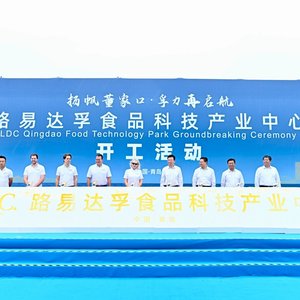Bentoli Workshop 2007 Emphasizes Strategic Use of Fishmeal in Aqua Feeds
Nearly fifty representatives of aquafeed manufacturing companies worldwide attending the Bentoli Workshop on Fishmeal Use were told that fishmeal, a highly valuable aquafeed ingredient, is a finite resource and that it has to be managed strategically in aquafeed formulas to get the most out of it and at the same time manage costs associated with its use.
The workshop was held on February 26, 2007 in San Antonio, Texas, USA, just a day before World Aquaculture 2007, the largest international aquaculture show opened. Eight experts spoke on various topics.
Opening the workshop, Dr. Jonathan Shepherd, the Director General of the International Fishmeal and Fish Oil Organization, remarked that average annual production of fishmeal is fairly stable at 5-7 million tonnes indicating that fishmeal resources are sustainable and well-managed. There are short-term fluctuations in supply due to periodic El Nińo warm currents off the Pacific coast of South America. Growth of aquaculture, particularly in China, creates a strong demand for fishmeal. As a result, fishmeal prices doubled in 2006.
Dr. Shepherd cited the case of feed manufacturers learning to manage fishmeal levels in poultry and swine feeds in the past, and told that fishmeal usage in aquaculture would also be managed by increasing levels of complementary ingredients when fishmeal prices are high. He said that it is likely that prices will continue to remain firm as fishmeal and fish oil move from being commodities to strategic ingredients used at critical stages in the life cycle for optimum health and performance. The challenge for the formulator will be to optimize diet costs with less fishmeal, but without compromising fish performance or losing the omega-3 related health benefits for the final consumer.
Speaking on the value of fishmeal in aquafeeds, Dr Ronald Hardy, the Director of the Aquaculture Research Institute at the University of Idaho, mentioned that the aqua feed industry must now focus on the qualities of fishmeal that have the highest value in aqua feeds, and limit fishmeal use to situations where its value is realized. He said that fishmeal is a high-value ingredient in starter feeds even for omnivorous fish species. As pond culture in Asian countries shifts from extensive rearing where no prepared feeds are used to semi-intensive rearing where formulated feeds are used, there is demand for fishmeal to be used in feeds for the fry and fingerlings of omnivorous fish such as carp, catfish and tilapia. He concluded that fishmeal is an important ingredient in fry and fingerling production, and will continue to be valued as such.
Dr. Allen Davis, an Associate Professor at the Department of Fisheries and Allied Aquacultures, Auburn University, Alabama, narrated his research experience on fishmeal replacement in practical shrimp feeds and asked feed manufacturers to consider data from trials that showed that no fishmeal is needed in the diets of Pacific white shrimp (vannamei) that are raised in ponds. He said that cheaper, high quality plant (e.g. combinations of solvent extracted soybean meal, corn gluten meal, distillers grain solubles, pea meal) or terrestrial animal protein sources (e.g. poultry meal) can be used to successfully replace fish meal in shrimp feeds without compromising shrimp growth.
Such modifications to the feed, however, can only be done if the replacement strategy takes into account nutrient requirements of the species in terms of essential amino acids, fatty acids and minerals as well as potential palatability shifts in the diets. He also asked that nutrient requirements of shrimp in pond systems be determined more precisely, especially in the case of limiting nutrients such as sulfur amino acids.
Dr Alberto Nunes, who directs the Labomar research program on shrimp feeds at the Instituto de Ciências do Mar, Brazil, spoke about feeding effectors in shrimp. Using a system called Y-maze aquarium, his laboratory has evaluated a number of ingredients and commercial feeding effectors in shrimp feeds. He mentioned that some ingredients such as fish oil which are commonly perceived as feed attractants are not effective at all as feed attractants. Providing data on his research on Aqua Savor®, a commercial attractant manufactured by Bentoli AgriNutrition, he said that the product was a highly effective feed attractant, incitant and feeding stimulant that worked at levels as low as 0.2% in feeds that contained no fishmeal. It also improved feed intake of feeds containing fishmeal, demonstrating its effectiveness as a fishmeal fortifier.
Dr. David Stone, who is a Research Scientist with the Aquaculture Research Institute at the University of Idaho, spoke about his research experience in the use of plant proteins in aqua feeds. He said that plant protein ingredients that are already in use in practical feeds include soy bean meal and corn gluten meal. He said that there is potential for modified ingredients from oilseed or grain protein concentrates made to feed grade standards such as soy beans, barley, rapeseed, lupins, etc.
Proteins recovered from ethanol or bio-fuel production also have tremendous potential. Presenting the case of the channel catfish industry in the Mississippi Delta region of Southern USA, he said that strategic nutrition research investigating nutrient requirements, nutrient digestibility and availability and growth studies has led to the production of grow-out diets containing soybean meal in combination with several other plant ingredients to replace all the fish meal with no ill affect on fish growth for this industry.
He remarked that fishmeal replacement for carnivorous species is proving to be more difficult. Rainbow trout may be grown successfully on all plant diets, assuming amino acid requirements have been met by supplementation, but growth appears to be approximately 5-10% less than trout fed fishmeal-containing feeds.
Reviewing past work on plant protein use in shrimp feeds, Dr. Addison Lawrence, a Professor and Regents Fellow in the Texas A&M University System, said that soybean meal can be included up to 50% with no detrimental effects. Further increase in soybean meal levels results in pelleting problems and requires the use of oil and binders. He said that methionine, lysine, and arginine, the three most limiting essentially amino acids in shrimp feeds, are not as limiting as protein levels in least cost formulated feeds. He said that the potential for increasing plant meal levels into shrimp feeds at the present time is most limited by the availability of a cost effective food grade plant protein source containing at least 60% protein with a digestibility value of over 85%.
There is a need for the production of a feed grade plant protein source such as soybean concentrate, corn gluten and wheat gluten. He further showed that there is a need to improve the digestibility of byproducts from corn processing and distilleries to make those products more valuable.
Dr. Sergio Nates, the President and Director of Technical Services of the Fats & Proteins Research Foundation, spoke on the use of rendered animal byproducts in aqua feeds. He remarked that a wide variety of byproducts are available and many present cost-effective opportunities for fishmeal replacement. Some products such as meat and bone meal and poultry byproduct meal are highly digestible protein sources. Recent research has shown that they can be significant sources of cholesterol, an essential nutrient in shrimp feeds.
Providing a case study of formulating practical shrimp feeds, Dr. Victor Suresh, Research Director of Bentoli AgriNutrition, said that practical alternatives to fishmeal were difficult to find in the 40% protein shrimp feeds. This situation, however, changed dramatically as crude protein levels in feeds fell to 35% and lower. At the current price of US$ 1070/tonne, fishmeal was included at a very low level (< 2%) or not at all in different versions of shrimp feeds containing 35% or 30% crude protein. Only at prices below US$ 500/tonne, fishmeal is justified in the lower protein formulas. Among the different ingredients that replace fishmeal, rendered animal proteins are generally favored over plant proteins in high protein formulas while plant proteins are favored in the lower protein formulas.
He said that aspects such as attractability/palatability in ingredients deserve as much attention as the more quantifiable nutrients. It is important to develop methods to quantify such aspects and plug the values into the formulation system so that formulators can effectively manage ingredients and produce diets that are nutritionally adequate and meet the performance goals of the farmer.
Mr. Edward Robinson, Operations Director of Bentoli AgriNutrition thanked the participants and speakers for making the workshop a success. Earlier, Mr William Robinson, the Chief Executive Officer and President of Bentoli AgriNutrition welcomed the gathering.










